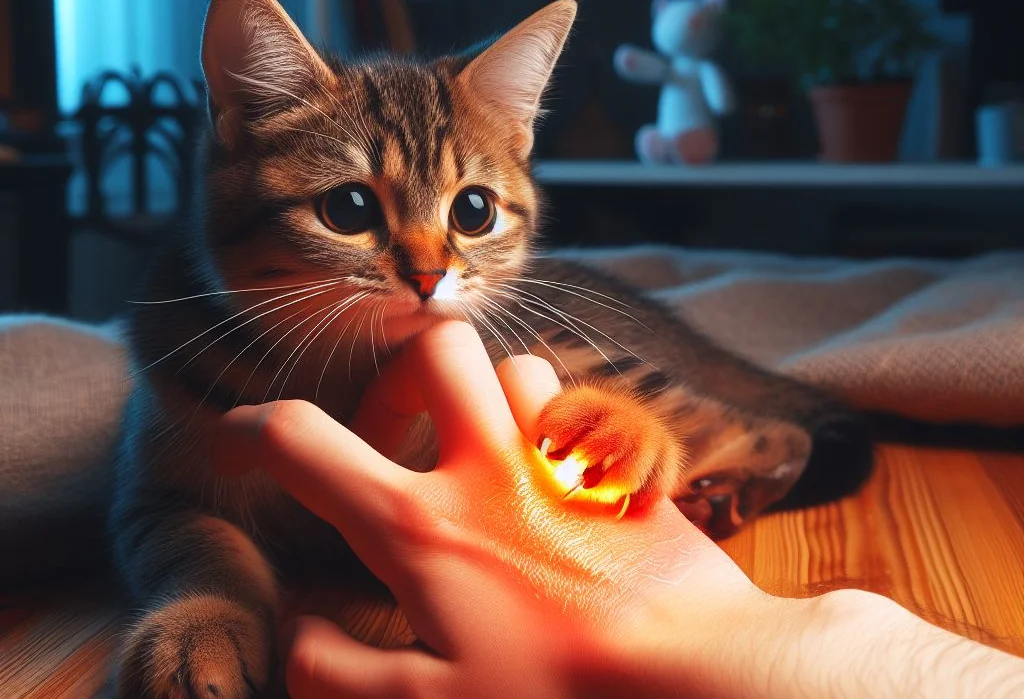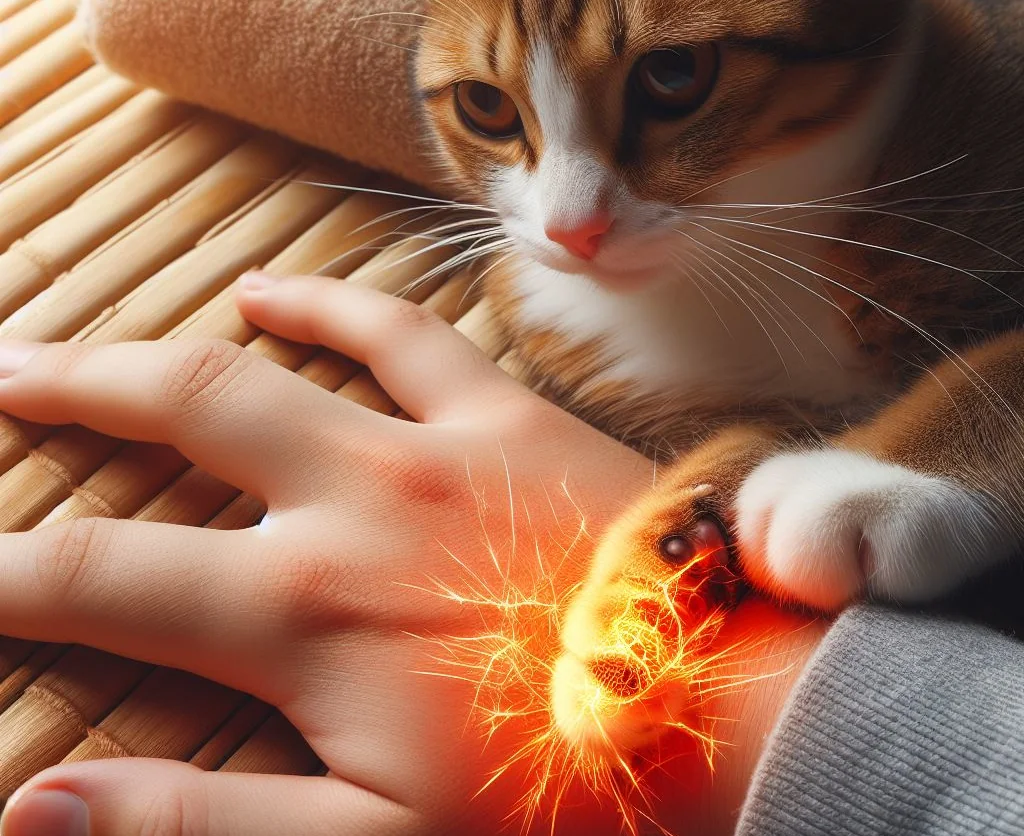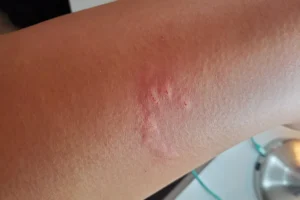We’ve all been there – you’re enjoying a blissful bonding moment with your feline friend, and suddenly, you’re left with a scratch that burns like the devil’s own handshake. It’s almost like our beloved kitties come equipped with their own set of spicy needles.
But before you start questioning if your cat might secretly be a chili pepper on four legs, let’s get to the bottom of this fiery mystery together. In this blog post, you’re going to find out exactly why cat scratches can feel like they’re burning and whether or not this is cause for concern.
Quick Takeaways:
- Wash and apply antiseptic to cat scratches immediately to prevent infection.
- Learn your cat’s body language to avoid scratches before they happen.
- Keep your cat’s nails trimmed and provide a safe retreat to minimize scratching incidents.
Why Do Cat Scratches Burn?
Ever wondered why a seemingly innocent scratch from your furry friend can feel like a brush with fire? It’s not just your imagination – there’s a whole host of reasons why cat scratches can quite literally burn you up.
Cats carry a variety of bacteria under their claws, an unavoidable consequence of their grooming habits and an active outdoor lifestyle. When those sharp little claws break your skin, they introduce foreign bacteria into your body. Your immune system doesn’t take kindly to these uninvited guests, launching a response that includes inflammation and, yes, that burning sensation. It’s a bit like your body sounding the alarm, letting you know it’s working hard to fend off potential infection.
Can Cat Scratches Cause Serious Health Issues?
While most cat scratches are more annoying than dangerous, they’re not to be taken lightly. One notable foe is Cat Scratch Fever (Cat Scratch Disease), a bacterial infection caused by Bartonella henselae. Though rare, it’s a real concern that can arise from something as simple as a loving scratch from your pet.
Symptoms to watch for include swelling around the scratch or bite, fever, fatigue, and swollen lymph nodes. It’s an ensemble of nasties that signals it’s time to pay your doctor a visit.
Apart from Cat Scratch Fever, other potential risks include bacterial infections like staphylococcus or streptococcus. While less common, the reality is that any break in the skin can become a doorway to infection if not properly managed.

How Can You Treat a Cat Scratch at Home?
So, you’ve been on the receiving end of a love scratch from your kitty – what now? Before panic sets in, rest assured there are several simple steps you can take to minimize the risk of complications:
Immediate Actions
-
Clean the Wound : First things first, thoroughly wash the scratch with soap and water. This can flush out bacteria and is your first line of defense against infection.
-
Apply Antiseptic : After cleaning, a dab of antiseptic – such as Neosporin – can offer added protection against bacteria.
-
Monitor the Scratch : Keep an eye on the scratch for signs of infection, such as increased redness, warmth, swelling, or pus.
Unique Advice
A tip that’s often overlooked is to apply a warm compress to the affected area. This isn’t just about comfort; the warmth can increase blood flow to the site, aiding your body’s healing process and potentially reducing swelling and discomfort.
Over-the-Counter Pain Relief
If the scratch is particularly nagging, consider taking an over-the-counter pain reliever. Options like acetaminophen (Tylenol) or ibuprofen (Advil) can reduce pain and manage any swelling.
In essence, while a cat scratch burning is a sign that your body is reacting as it should to an intrusion, it’s vital to take the necessary steps to prevent infection. With the right care, those fiery little reminders of our feline friends’ affection won’t escalate into anything more ominous. Remember, when in doubt, or if symptoms persist or worsen, reaching out to a healthcare provider is the best course of action.

How Can You Prevent Cat Scratches?
Getting scratched by your cat can range from a mild annoyance to a painful experience. But let’s face it, our feline friends aren’t out to get us — most scratches are simply a form of miscommunication. So, how can you minimize these scratchy encounters? Let’s dive into some tried-and-tested tips, sprinkled with a touch of unique insight to keep both you and your kitty happy and scratch-free.
Understand Feline Body Language
First and foremost, learning to interpret your cat’s body language is like being given a key to a secret garden. Cats are highly expressive creatures, and their body language can signal when they’re feeling playful, irritated, or downright cranky. Look for telltale signs like a twitching tail, flattened ears, or a puffed-up coat — these are your cat’s way of saying, “Back off!” Respecting these signals and giving your cat some space can drastically reduce the likelihood of getting scratched.
Behavioral Training for Your Cat
Yes, cats can be trained! While they may not fetch your slippers, with patience and consistency, you can teach your cat acceptable behaviors and boundaries. Here’s a kicker that many might overlook: use positive reinforcement to encourage gentle play. Rather than using your fingers as toys, introduce a variety of cat toys that allow your kitty to pounce and swipe safely. When your cat plays nicely, reward them with treats or affection. Over time, they’ll associate gentle play with positive outcomes.
Keep Your Cat’s Nails Trimmed
Regularly trimming your cat’s nails can make those accidental scratches less painful. Think of it as blunting the tips of tiny swords — they might still poke you, but the cut won’t be as deep. If you’re new to this, consider asking a vet or a groomer to show you the ropes. It’s crucial to avoid cutting into the quick, as that can be painful for your cat and might make them even more averse to future nail trims. Here’s a pro tip: invest in a high-quality pair of nail clippers specifically designed for cats to make the process smoother for both of you.
Unique Insight: Create a Safe Retreat
Here’s something you might not find on every cat care blog: Designate a ‘safe retreat’ for your cat. Cats, being both predator and prey animals, instinctively seek safe spaces, especially when they’re feeling overwhelmed. By providing a designated area — be it a cozy cat bed in a quiet corner, a cat tree, or even a cardboard box — you’re giving your cat a go-to spot where they can decompress. This can significantly reduce stress-induced scratching, as your cat has an escape route when they feel cornered or scared. Plus, it’s a simple addition to your home that can make a world of difference to your cat’s sense of security.
In a Nutshell
Minimizing cat scratches comes down to a mix of understanding, training, and a little bit of preemptive action. Listen to what your cat’s trying to tell you; invest time in teaching them the ropes of gentle play; keep those claws in check, and provide a safe space for when the world feels a bit too much. Not only will these steps help keep your skin free from scratches, but they’ll also nurture a deeper bond between you and your feline friend, built on mutual respect and understanding.
Remember, every cat has its personality, and what works for one may not work for another. Be patient, be consistent, and don’t be afraid to seek advice from professionals if you’re facing recurring issues. Above all, cherish the unique relationship you have with your cat — scratches and all.
Alex, a passionate animal lover, has experience in training and understanding animal behavior. As a proud pet parent to two dogs and three cats, he founded AnimalReport.net to share insights from animal experts and expand his knowledge of the animal kingdom.





